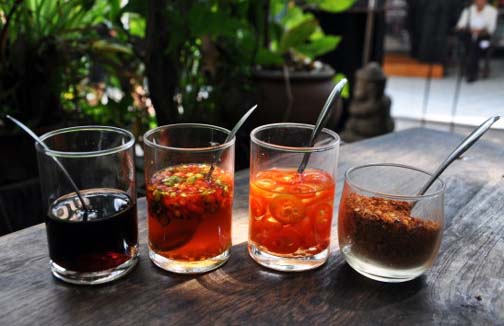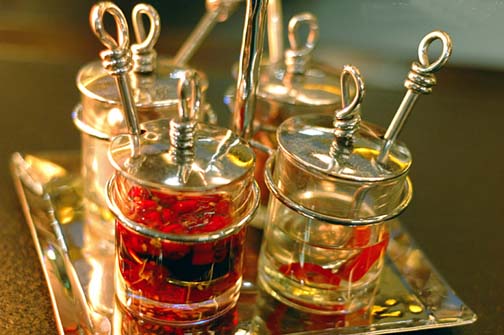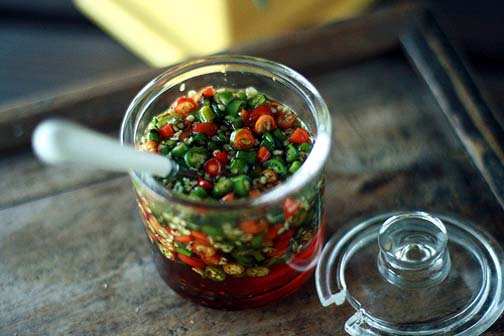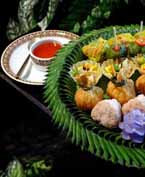The nice thing about farang who insist on eating the familiar while visiting Thailand is that there is no confusion involved in chomping down on a Big Mac or gnashing your way through the gristle served as steak at Sizzler. Other than why you are eating at those places. Anywhere in the world. Sooner or later for the rest of us, you will find yourself seated at a table soon to be laden with Thai delicacies. The dishes you order may seem foreign, but having ordered them you do at least know what they are. At least by name. And just in case you don’t your server will usually mumble its identification as he or she brings each dish to your table. Which is a good thing. Otherwise you’d assume the appetizer you ordered would be the first dish served. More likely it’ll come sometime during the middle of the meal. Which while par for the course, for a newbie illustrates the real problem with eating local. Thais do things the Thai way, and that includes eating a meal. And while it’s all fine and good to follow the adage when in Rome do as the Romans do, that’s a bit difficult to do when you have no idea what they are doing, why they are doing it, or what it is you are supposed to do.
That the various dishes you order are served as they are cooked, not in the silly farang custom of appetizer first, etc. is one example of the problems you’ll experience when dining at a Thai restaurant. But then when your stomach is growling, who cares? That the utensils at your place are an odd configuration may give you a moment’s’s pause too, but you can easily watch someone else or just go with what seems right. Getting the food into your mouth is, after all, your primary goal. And if the local children at the next table giggle at your naivete and strange dining habits . . . well, local kids have probably been laughing at you during your entire trip anyway. The little bowls, jars, and containers siting in the center of your table – with a seemingly never-ending display of more appearing throughout your meal – are a different story. It’s not rocket science to figure out those are condiments. Of some sort. What each is and when or why you should use them – or not – is a bit more problematic.
The foreign dining standby of watching what the locals do and then mimic them usually works well. Until you get to the condiments on a Thai dinner table. You’d swear the locals are just as confused as you. Everyone seems to have their own opinion on what to do with that stuff. Some use liberal amounts of everything, others pick and choose. But no one ignores condiments entirely. Except for farangs who figure the safest course is avoidance. Thais tend to find enjoyment in everything they do. And nothing is more fun at a dinner table than customizing your food. Whereas in the West it may be insulting to the chef to add more salt or pepper to your food, in Thailand it is expected. And encouraged.
While you may (but probably won’t) find salt and pepper on your table, you will find a variety of sauces and powders, the standard being a small caddy of four containers called khreuang puang, or for the farang tongue if not taste buds, circle of spices. From the lowliest of street food carts to the reigning 5-star restaurant in town the circle of spices is de rigueur for Thai dining. These spices are your friend, get to know them. They will add an unsuspected nuance to your meal. Or at least you won’t find that you just doused your entire meal with spoonfuls of sugar. Best yet, whatever the meal, by using the condiments provided you can have it your way. Just like at Burger King, Now doesn’t that sound more familiar?
Thais are not big on rules. At best they ignore them. So while you can always expect to see a set of four condiments on your table, don’t expect them to always be the same four. There are variations for each of the standard condiments. And depending on the type of restaurant you are dining at, there are some condiments specifically meant for that style of food. Regardless, and whatever the configuration, these condiments are generally provided to give you four basic flavoring options: namely hot, sour, salty, and sweet.
You Say Tomato.
Actually, you probably say salt. Thais say nam pla. It is the salt of the Thai table and kitchen and a must for Thai dining. Nam pla is a fish sauce that imparts a unique character to Thai food The basic version is made with fermented fish – usually anchovies – that when used in proper proportions is very subtle with no hint of a seafood taste. Like salt, nam pla adds a fullness and depth to the flavor of a dish. Sometimes rather than being in a standard condiment container it appears on your table in a bottle. And quite often, rather than the basic nam pla you’ll see prik nam pla instead, in which small sliced chilies have been added. This is also the condiment that may include pulverized water bugs. For the newbie prik nam pla can be confused with prik dong (aka nam som prik) which also features sliced chilies. But prik dong uses a vinegar base for a sour taste instead of the salty taste provided by nam pla.
If The Name Of Phuket Makes You Giggle.
Nam prik, or nam som prik, is probably the better way to say it but not nearly as fun as prik dong. The most basic version is made of sliced green chilies in vinegar. The chili part probably makes you think of hot spiciness, but it’s intent is to add sour to your dining experience. Like nam pla there are thousands of variations, what you are served usually depends on the region or type of food that particular establishment specializes in. If both prik dong and prik nam pla are part of your circle of spices, the prik dong will usually be thicker, and more of a paste. But of course, not always. When both are more of a watery sauce, the prik dong will usually have larger slices of chilies in it. Generally, the thicker and browner the prik dong is, the more spicy it will be too. No problemo. If that prik dong adds to much heat for you . . .
A Spoonful of Sugar.
Like countless touri before you, if you didn’t know better you probably thought that small bowl of white granules sitting on the table was salt. Surprise! You’re probably familiar with sugar being made available when coffee is served, as a flavoring for your meal, not so much. But Thais love the stuff. And if you have never liberally doused your pad thai with sugar, you haven’t tasted pad thai. Obviously, sugar is meant to add a sweet taste to your food. But it works equally well to balance a dish’s spiciness. Especially when you already added too much prik dong. Usually the sugar served in a circle of spices is made from sugar cane; then it is white. Occasionally (and often at pad thai stalls) it is brown, or black as Thais call it, and it is sugar made from coconut palm trees instead.
So Many Priks, So Little Time.
Rounding out the standard circle of spices is prik pon, which is roasted chili powder and is used to add both heat and spice to your food. Sometimes it is a finely ground powder, sometimes more of a flaky concoction. Often it has a nice smoky edge to it in addition to the heat. It’s not a popular condiment among farang, even the watered down version of Thai food served to white faces is already hot enough if not too spicy. If the prik dong served is a hot version you may not see chili powder on your table; there are plenty of other Thai condiments to take its place. ‘Cuz serving up the exact same four condiments at every meal and at every restaurant would just make too much sense.

Soy sauce, Prik Nam Pla, Prik Dong, and Prik Pon . . . if you don’t know if that’s left to right or right to left you are in for a dining experience!
Just When You Thought It Was Safe To Go Back To The Dinner Table.
These four condiments are the standard at most restaurants, particularly noodle shops (because all four are necessary for bland noodle dishes). Fish sauce, and or fish sauce with chilies, shows up 99.9% of the time regardless of the type of food served. The others not so much. Sometimes there is soy sauce (which means you are eating at a Chinese restaurant), sometimes a version of Sriracha, which balances sweet and sour with heat, a kind of 3-in-1 taste treat for your mouth.
Chopped peanuts are popular too and a requirement at any pad thai restaurant. Tamarind pulp – which looks like some of the disgusting things they do with the parts of a chicken you’d never allow to pass through your lips – is popular as a condiment for pad thai too. The best rule of thumb is at a noodle or pad thai shop add a bit of every condiment available. Experiencing the exotic and foreign is what travel is all about. Even when it is just your mouth taking the gamble. And if that ruins your meal, there’s a McDonalds just down the street.
Related Posts You Might Enjoy:






